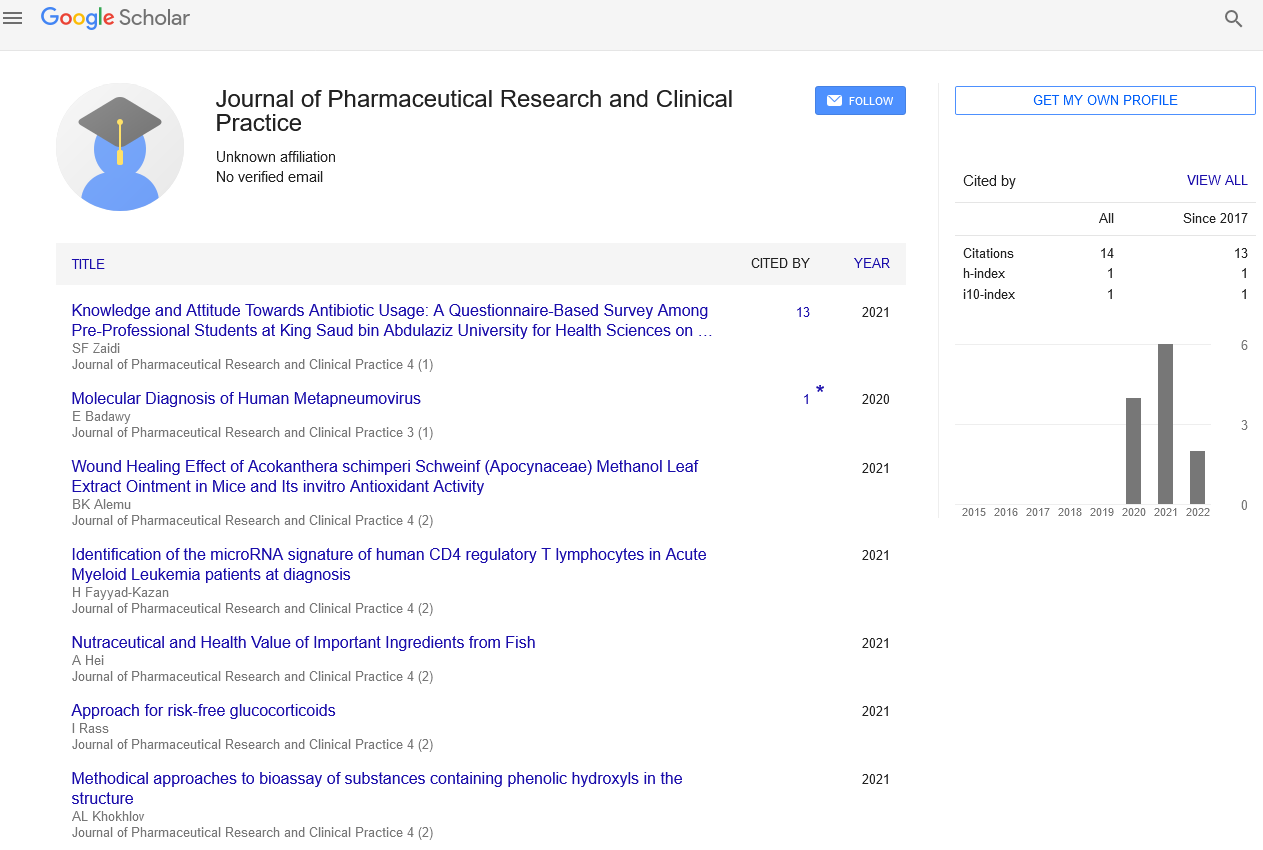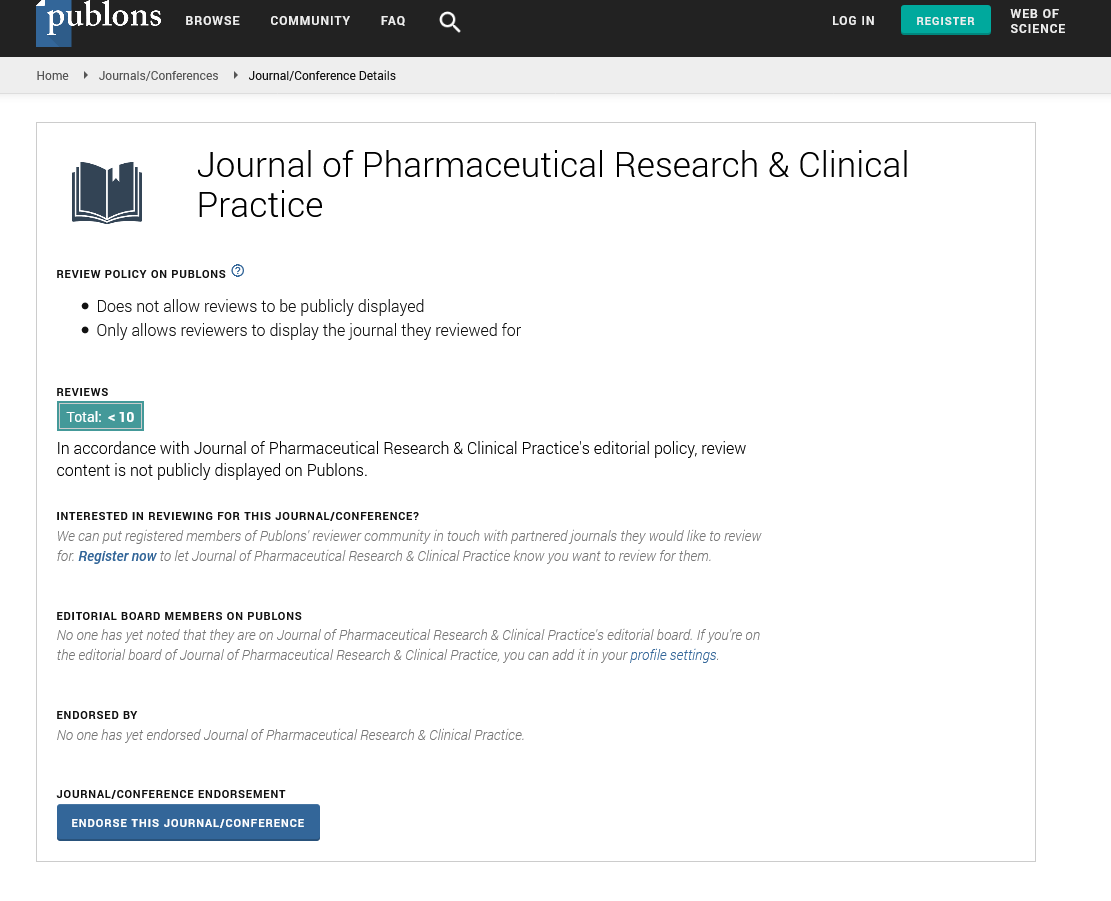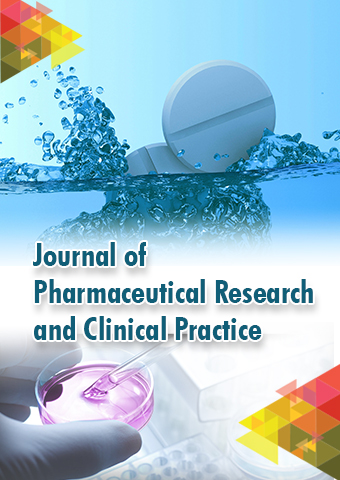Editorial - Journal of Pharmaceutical Research and Clinical Practice (2023) Volume 6, Issue 3
Advancements in Drug Formulation: Innovations Shaping the Future of Medicine
Jash Peter*
Department of Pharmaceutical research, Japan
Department of Pharmaceutical research, Japan
E-mail: peter_jash69@gmail.com
Received: 02-June-2023, Manuscript No. jprcp-23-104122; Editor assigned: 05-Jun-2023, PreQC No. jprcp-23- 104122(PQ); Reviewed: 19-Jun- 2023, QC No. jprcp-23-104122; Revised: 23-Jun-2023, Manuscript No. jprcp-23-104122 (R); Published: 30-Jun-2023; DOI: 10.37532/ jprcp.2023.6(3).62-65
Abstract
The field of drug formulation has witnessed remarkable advancements that are reshaping the future of medicine. Innovations in drug formulation have focused on improving drug delivery, enhancing bioavailability, and optimizing therapeutic outcomes. This article highlights key developments in the field, including nanotechnology and nanomedicine, controlled release systems, personalized medicine, biologics, and 3D printing. These innovations offer tremendous potential in enhancing drug efficacy, ensuring patient safety, and promoting adherence. Nanoparticles and nanocarriers enable targeted drug delivery, while controlled release systems provide sustained release for improved patient compliance. Personalized medicine utilizes pharmacogenomics and pharmacokinetics to tailor treatments according to individual characteristics. The emergence of biologics necessitates novel delivery systems to overcome stability and immunogenicity challenges. Additionally, 3D printing enables the creation of complex drug structures and personalized dosage forms. These advancements are paving the way for personalized, targeted, and patient-centric medicine, heralding a transformative era in healthcare.
Keywords
Drug formulation • Advancements • Innovations • Future of medicine • Nanotechnology
Introduction
Advancements in drug formulation have significantly contributed to the progress and evolution of modern medicine. The development of innovative drug formulations plays a crucial role in enhancing drug efficacy, improving patient safety, and promoting better therapeutic outcomes [1]. Over the years, researchers and scientists have dedicated their efforts to exploring novel approaches in drug formulation, resulting in groundbreaking innovations that are reshaping the future of medicine. The field of drug formulation encompasses a wide range of techniques and technologies aimed at optimizing the delivery of pharmaceutical compounds to target sites within the body [2]. By carefully designing drug formulations, scientists can overcome various challenges associated with drug development, such as poor solubility, instability, limited bioavailability, and undesirable side effects. Through the application of innovative strategies, researchers have made significant progress in addressing these challenges, ultimately leading to improved patient outcomes [3]. In this article, we will explore some of the most noteworthy advancements in drug formulation that are driving the future of medicine. These advancements encompass various areas, including nanotechnology and nanomedicine, controlled release systems, personalized medicine, biologics, and 3D printing. Each of these innovations offers unique opportunities to enhance drug delivery, tailor treatments to individual patients, and revolutionize the way medications are developed and administered [4]. The utilization of nanotechnology and nanomedicine has opened new frontiers in drug formulation. By manipulating materials at the nanoscale, researchers have been able to develop nanoparticles and nanocarriers capable of encapsulating and delivering drugs with improved precision and efficiency. These nanosystems offer advantages such as targeted drug delivery, enhanced cellular uptake, and controlled release, thereby maximizing therapeutic efficacy while minimizing adverse effects [5]. Controlled release systems have also emerged as a significant advancement in drug formulation. These systems enable the sustained release of drugs over a prolonged period, allowing for a more controlled and consistent therapeutic effect. By overcoming the limitations of immediate-release formulations, controlled release systems enhance patient compliance and reduce the frequency of drug administration. This result in improved treatment outcomes and a better overall patient experience [6]. Personalized medicine is another exciting area in drug formulation that holds immense promise for the future. By considering an individual’s genetic makeup, lifestyle factors, and disease characteristics, personalized medicine aims to optimize drug dosing and tailor treatments to each patient’s specific needs [7]. This approach utilizes cutting-edge technologies like pharmacogenomics and pharmacokinetics to determine the most effective and safe drug regimens for each individual, improving therapeutic outcomes and minimizing adverse reactions. The advent of biologics, including monoclonal antibodies and gene therapies, has revolutionized the treatment of various diseases [8]. However, the unique characteristics of biologics, such as their sensitivity to degradation and potential immunogenicity, present challenges in their formulation and delivery. Innovations in drug formulation have focused on developing novel delivery systems that protect and target biologic drugs more effectively, ensuring their stability and enhancing their therapeutic potential. Furthermore, 3D printing has emerged as a transformative technology in drug formulation. This innovative approach allows for the precise fabrication of complex drug structures and personalized dosage forms [9]. 3D printing enables the creation of patient-specific drug delivery systems, multi-drug combinations, and intricate drug matrices, opening up new possibilities for personalized medicine, pediatric formulations, and individualized treatment approaches. Advancements in drug formulation are revolutionizing the field of medicine, offering exciting opportunities to enhance drug delivery, improve therapeutic outcomes, and provide personalized treatments. The integration of nanotechnology, controlled release systems, personalized medicine, biologics, and 3D printing is shaping the future of medicine, ushering in a new era of targeted, efficient, and patient-centric healthcare [10]. By harnessing these innovative technologies, researchers and healthcare professionals can strive towards optimal drug formulations that maximize efficacy, safety, and patient well-being.
Discussion
In the ever-evolving field of pharmaceuticals,drug formulation plays a pivotal role in ensuring the efficacy, safety, and patient compliance of medications. Over the years, researchers and scientists have made significant strides in developing innovative drug formulations that enhance drug delivery, improve bioavailability, and optimize therapeutic outcomes. This article explores the latest advancements in drug formulation, highlighting key innovations that are shaping the future of medicine. The field of drug formulation is experiencing a rapid transformation, driven by groundbreaking innovations and technologies. Nanotechnology, controlled release systems, personalized medicine, biologics, and 3D printing are revolutionizing drug development and delivery. These advancements hold the promise of more effective treatments, reduced side effects, and improved patient outcomes. As research continues, we can expect to witness further breakthroughs in drug formulation, ushering in a new era of personalized, targeted, and patientcentric medicine.
Nanotechnology and Nano medicine
Nanotechnology has revolutionized drug formulation by enabling the design and development of nanoparticles and nanocarriers. These tiny structures offer unique advantages, such as increased drug stability, controlled release, and enhanced cellular uptake. Nanoparticles can encapsulate a wide range of drugs, including small molecules, proteins, and nucleic acids, and can be tailored to target specific tissues or cells. Nanomedicine holds tremendous potential in the treatment of various diseases, including cancer, cardiovascular disorders, and infectious diseases.
Controlled release systems
Controlled release systems have emerged as a game-changer in drug formulation, ensuring sustained drug release over an extended period. By overcoming the limitations of conventional immediate-release formulations, controlled release systems enhance patient compliance and reduce side effects. These systems utilize specialized technologies like hydrogels, microspheres, and transdermal patches, enabling precise modulation of drug release rates. They find applications in chronic pain management, hormone replacement therapy, and treatment of psychiatric disorders.
Personalized medicine
Advancements in drug formulation have paved the way for personalized medicine, tailoring treatments to an individual’s genetic makeup, lifestyle, and disease characteristics. By incorporating technologies like pharmacogenomics and pharmacokinetics, personalized medicine optimizes drug dosing and minimizes adverse reactions. Customized drug formulations can be created to meet specific patient needs, ensuring maximum therapeutic efficacy while minimizing toxicity.
Biologics and novel delivery systems
Biologic drugs, including monoclonal antibodies and gene therapies, have emerged as a cornerstone of modern medicine. Drug formulation strategies have evolved to address the unique challenges associated with biologics, such as stability, immunogenicity, and delivery. Novel delivery systems, such as liposomes, polymerbased carriers, and exosomes, offer improved protection and targeted delivery of biologic drugs, enhancing their therapeutic potential.
3D printing in drug formulation
Three-dimensional (3D) printing has revolutionized various industries, including pharmaceuticals. In drug formulation, 3D printing allows the creation of complex drug structures with precise control over drug release profiles. This technology enables the production of personalized drug dosage forms, multi-drug combinations, and intricate drug matrices. The flexibility of 3D printing opens up new possibilities in personalized medicine, pediatric formulations, and patient-specific drug delivery systems.
Conclusion
The continuous advancements in drug formulation are poised to revolutionize the future of medicine. Through groundbreaking innovations in nanotechnology, controlled release systems, personalized medicine, biologics, and 3D printing, the field is witnessing remarkable transformations that enhance drug delivery, improve therapeutic outcomes, and prioritize patient-centric care. Nanotechnology and nanomedicine offer precise drug targeting, controlled release, and improved cellular uptake, revolutionizing the efficacy and safety of drug formulations. Controlled release systems provide sustained drug release, ensuring patient compliance and reducing side effects. Personalized medicine, leveraging pharmacogenomics and pharmacokinetics, enables tailored treatments based on individual characteristics, maximizing therapeutic benefits while minimizing adverse reactions. The emergence of biologics has necessitated novel delivery systems to overcome stability and immunogenicity challenges. Innovations in drug formulation enable the protection and targeted delivery of biologic drugs, unlocking their full potential for treating complex diseases. Furthermore, 3D printing empowers the creation of intricate drug structures and personalized dosage forms, paving the way for individualized treatments and enhanced patient outcomes. These advancements collectively reshape the landscape of medicine, propelling the field towards targeted, efficient, and patient-centric healthcare. By integrating these innovative technologies, researchers and healthcare professionals can strive for optimal drug formulations that maximize efficacy, safety, and patient well-being. As research and development continue, the future of drug formulation holds even more promise. Further advancements in nanotechnology, personalized medicine, and 3D printing are expected to revolutionize drug development and delivery, ushering in an era of tailored treatments and precision medicine. By harnessing these innovations, we can anticipate a future where medications are optimized for each individual, providing highly effective and personalized therapeutic solutions. The advancements in drug formulation are driving the future of medicine by enhancing drug delivery, improving therapeutic outcomes, and prioritizing patient needs. These innovations mark a transformative shift towards personalized, targeted, and patient-centric care, paving the way for a new era in healthcare where medications are tailored to individuals, resulting in improved treatment efficacy and quality of life. With each advancement we move closer to realizing the full potential of drug formulation in shaping a healthier future for all.
References
- Hoffman JI.Congenital heart disease: Incidence and inheritance.PediatrClin N Am. 37, 25–43(1990).
- Moller JH, Allen HD, Clark EBet al.Report of the task force on children and youth. American Heart Association.Circulation. KidneyCancer88, 2479–2486(1993).
- Bruneau BG.The developmentalgeneticsof congenital heart disease.Nature. 451, 943–948(2008).
- Nemer M.Genetic insights into normal and abnormal heart development Cardiovasc.Pathol. 17, 48–54(2008).
- Srivastava D, Olson EN.A genetic blueprint for cardiac development.Nature. 407, 221–226(2000).
- Luchini C, Pea A, Scarpa A.Artificial intelligence in oncology: Current applications and future perspectives.Br J Cancer. 126, 4–9(2022).
- Shapiro Charles L.Cancer Survivorship.N Engl J Med. 379, 2438–2450 (2018).
- Lu C, Bera K, Wang Xet al.A prognosticmodelfor overall survival of patients with early-stage non-small celllungcancer: A multicentre, retrospective study.Lancet Digit Health. 2, 594–606 (2020).
- Singla N, Singla S.Harnessing Big Data withMachine Learningin Precision Oncology.KidneyCancerJ. 18, 83–84(2020).
- Mu W, Jiang L, Zhang Jet al.Non-invasive decision support for NSCLC treatment using PET/CT radiomics.Nat Commun. 11, 5228 (2020).
Indexed at, Google Scholar, Crossref
Indexed at, Google Scholar, Crossref
Indexed at, Google Scholar, Crossref
Indexed at,Google Scholar ,Crossref
Indexed at, Google Scholar, Crossref
Indexed at, Google Scholar, Crossref
Indexed at, Google Scholar, Crossref
Indexed at, Google Scholar, Crossref


